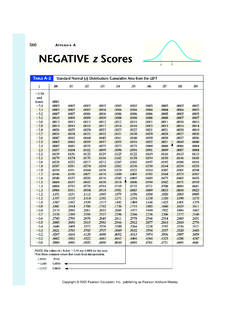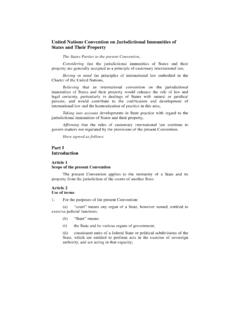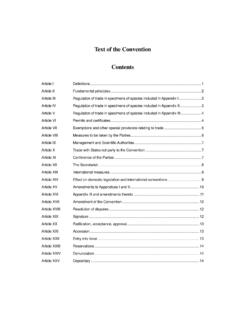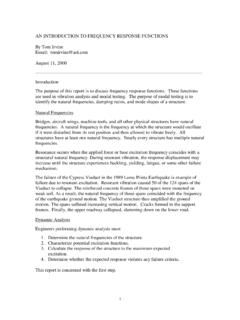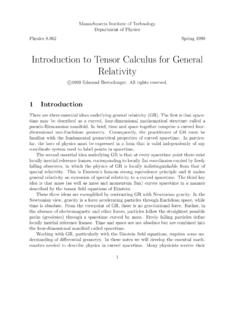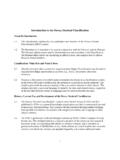Transcription of PART 1: INTRODUCTION TO TENSOR CALCULUS
1 1 PART 1: INTRODUCTION TO TENSOR CALCULUSA scalar field describes a one-to-one correspondence between a single scalar number and a point. An n-dimensional vector field is described by a one-to-one correspondence between n-numbers and a point. Let usgeneralize these concepts by assigningn-squared numbers to a single point orn-cubed numbers to a singlepoint. When these numbers obey certain transformation laws they become examples of TENSOR fields. Ingeneral, scalar fields are referred to as TENSOR fields of rank or order zero whereas vector fields are calledtensor fields of rank or order associated with TENSOR CALCULUS is the indicial or index notation. In section 1 the indicialnotation is defined and illustrated. We also define and investigate scalar, vector and TENSOR fields when theyare subjected to various coordinate transformations.
2 It turns out that tensors have certain properties whichare independent of the coordinate system used to describe the TENSOR . Because of these useful properties,we can use tensors to represent various fundamental laws occurring in physics, engineering, science andmathematics. These representations are extremely useful as they are independent of the coordinate INDEX NOTATIONTwo vectors~Aand~Bcan be expressed in the component form~A=A1be1+A2be2+A3be3and~B=B1be1+B2be 2+B3be3,wherebe1,be2andbe3are orthogonal unit basis vectors. Often when no confusion arises, the vectors~Aand~Bare expressed for brevity sake as number triples. For example, we can write~A=(A1,A2,A3)and~B=(B1,B2,B3)where it is understood that only the components of the vectors~Aand~Bare given.
3 The unit vectors wouldbe representedbe1=(1,0,0),be2=(0,1,0),be3=( 0,0,1).A still shorter notation, depicting the vectors~Aand~Bis the index or indicial notation. In the index notation,the quantitiesAi,i=1,2,3andBp,p=1,2,3represe nt the components of the vectors~Aand~ notation focuses attention only on the components ofthe vectors and employs a dummy subscript whose range over the integers is specified. The symbolAirefersto all of the components of the vector~Asimultaneously. The dummy subscriptican have any of the integervalues 1, 1 we focus attention on theA1component of the vector~ on the second componentA2of the vector~Aand similarly wheni= 3 we can focus attention onthe third component of~ subscriptiis a dummy subscript and may be replaced by another letter, sayp, so long as one specifies the integer values that this dummy subscript can is also convenient at this time to mention that higher dimensional vectors may be defined as orderedn tuples.
4 For example, the vector~X=(X1,X2,..,XN)with componentsXi,i=1,2,..,Nis called aN dimensional vector. Another notation used to representthis vector is~X=X1be1+X2be2+ +XNbeNwherebe1,be2,..,beNare linearly independent unit base vectors. Note that many of the operations that occur in the use of theindex notation apply not only for three dimensional vectors, but also forN dimensional future sections it is necessary to define quantities which can be represented by a letter with subscriptsor superscripts attached. Such quantities are referred to as systems. When these quantities obey certaintransformation laws they are referred to as TENSOR systems. For example, quantities likeAkijeijk ij subscripts or superscripts are referred to as indices or suffixes.
5 When such quantities arise, the indicesmust conform to the following rules:1. They are lower case Latin or Greek The letters at the end of the alphabet (u,v,w,x,y,z) are never employed as number of subscripts and superscripts determines the order of the system. A system with one indexis a first order system. A system with two indices is called a second order system. In general, a system withNindices is called aNth order system. A system with no indices is called a scalar or zeroth order type of system depends upon the number of subscripts or superscripts occurring in an example,AijkandBmst,(all indices range 1 to N), are of the same type because they have the samenumber of subscripts and superscripts. In contrast, the systemsAijkandCmnpare not of the same typebecause one system has two superscripts and the other system has only one superscript.
6 For certain systemsthe number of subscripts and superscripts is important. In other systems it is not of importance. Themeaning and importance attached to sub- and superscripts will be addressed later in this the use of superscripts one must not confuse powers of a quantity with the superscripts. Forexample, if we replace the independent variables (x,y,z)bythesymbols(x1,x2,x3),then we are lettingy=x2wherex2is a variable and notxraised to a power. Similarly, the substitutionz=x3is thereplacement ofzby the variablex3and this should not be confused withxraised to a power. In order towrite a superscript quantity to a power, use parentheses. For example, (x2)3is the variablex2cubed. Oneof the reasons for introducing the superscript variables is that many equations of mathematics and physicscan be made to take on a concise and compact is a range convention associated with the indices.
7 This convention states that whenever thereis an expression where the indices occur unrepeated it is to be understood that each of the subscripts orsuperscripts can take on any of the integer values 1,2,..,NwhereNis a specified integer. For example,3the Kronecker delta symbol ij, defined by ij=1ifi=jand ij=0fori6=j,withi,jranging over thevalues 1,2,3, represents the 9 quantities 11=1 21=0 31=0 12=0 22=1 32=0 13=0 23=0 33= symbol ijrefers to all of the components of the system simultaneously. As another example, considerthe equationbem ben= mnm,n=1,2,3( )the subscriptsm, noccur unrepeated on the left side of the equation and hence must also occur on the righthand side of the equation. These indices are called free indices and can take on any of the values 1,2or3as specified by the range.
8 Since there are three choices for the value formand three choices for a value ofnwe find that equation ( ) represents nine equations simultaneously. These nine equations arebe1 be1=1be2 be1=0be3 be1=0be1 be2=0be2 be2=1be3 be2=0be1 be3=0be2 be3=0be3 be3= and Skew-Symmetric SystemsA system defined by subscripts and superscripts ranging over a set of values is said to be symmetricin two of its indices if the components are unchanged when the indices are interchanged. For example, thethird order systemTijkis symmetric in the indicesiandkifTijk=Tkjifor all values ofi, system defined by subscripts and superscripts is said to be skew-symmetric in two of its indices if thecomponents change sign when the indices are interchanged. For example, the fourth order systemTijklisskew-symmetric in the indicesiandlifTijkl= Tljkifor all values another example, consider the third order systemaprs,p,r,s=1,2,3 which is completely skew-symmetric in all of its indices.
9 We would then haveaprs= apsr=aspr= asrp=arsp= is left as an exercise to show this completely skew- symmetric systems has 27 elements, 21 of which arezero. The 6 nonzero elements are all related to one another thru the above equations when (p,r,s)=(1,2,3).This is expressed as saying that the above system has only one independent ConventionThe summation convention states that whenever there arises an expression where there is an index whichoccurs twice on the same side of any equation, or term within an equation, it is understood to represent asummation on these repeated indices. The summation being over the integer values specified by the range. Arepeated index is called a summation index, while an unrepeated index is called a free index. The summationconvention requires that one must never allow a summation index to appear more than twice in any givenexpression.
10 Because of this rule it is sometimes necessary to replace one dummy summation symbol bysome other dummy symbol in order to avoid having three or more indices occurring on the same side ofthe equation. The index notation is a very powerful notation and can be used to concisely represent manycomplex equations. For the remainder of this section there is presented additional definitions and examplesto illustrated the power of the indicial notation. This notation is then employed to define TENSOR componentsand associated operations with two equationsy1=a11x1+a12x2y2=a21x1+a22x2can be represented as one equation by introducing a dummy index, sayk,and expressing the above equationsasyk=ak1x1+ak2x2,k=1, range convention states thatkis free to have any one of the values 1 or 2, (kis a free index).
